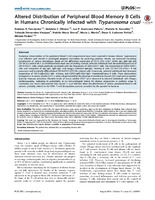Please use this identifier to cite or link to this item:
http://sgc.anlis.gob.ar/handle/123456789/1455| DC Field | Value | Language |
|---|---|---|
| dc.contributor.author | Fernández, Esteban R | en_US |
| dc.contributor.author | Olivera, Gabriela C | en_US |
| dc.contributor.author | Quebrada Palacio, Luz P | en_US |
| dc.contributor.author | Gonzalez, Mariela N. | en_US |
| dc.contributor.author | Hernandez-Vasquez, Yolanda | en_US |
| dc.contributor.author | Sirena, Natalia María | en_US |
| dc.contributor.author | Morán, María L. | en_US |
| dc.contributor.author | Ledesma Patiño, Oscar S | en_US |
| dc.contributor.author | Postan, Miriam | en_US |
| dc.date.accessioned | 2019-12-05T19:40:08Z | - |
| dc.date.available | 2019-12-05T19:40:08Z | - |
| dc.date.issued | 2014 | - |
| dc.identifier.uri | http://sgc.anlis.gob.ar/handle/123456789/1455 | - |
| dc.description.abstract | Numerous abnormalities of the peripheral blood T cell compartment have been reported in human chronic Trypanosoma cruzi infection and related to prolonged antigenic stimulation by persisting parasites. Herein, we measured circulating lymphocytes of various phenotypes based on the differential expression of CD19, CD4, CD27, CD10, IgD, IgM, IgG and CD138 in a total of 48 T. cruzi-infected individuals and 24 healthy controls. Infected individuals had decreased frequencies of CD19+CD27+ cells, which positively correlated with the frequencies of CD4+CD27+ cells. The contraction of CD19+CD27+ cells was comprised of IgG+IgD-, IgM+IgD- and isotype switched IgM-IgD- memory B cells, CD19+CD10+CD27+ B cell precursors and terminally differentiated CD19+CD27+CD138+ plasma cells. Conversely, infected individuals had increased proportions of CD19+IgG+CD27-IgD- memory and CD19+IgM+CD27-IgD+ transitional/naïve B cells. These observations prompted us to assess soluble CD27, a molecule generated by the cleavage of membrane-bound CD27 and used to monitor systemic immune activation. Elevated levels of serum soluble CD27 were observed in infected individuals with Chagas cardiomyopathy, indicating its potentiality as an immunological marker for disease progression in endemic areas. In conclusion, our results demonstrate that chronic T. cruzi infection alters the distribution of various peripheral blood B cell subsets, probably related to the CD4+ T cell deregulation process provoked by the parasite in humans. | en_US |
| dc.language.iso | en | en_US |
| dc.relation.ispartof | PloS one | en_US |
| dc.title | Altered distribution of peripheral blood memory B cells in humans chronically infected with Trypanosoma cruzi | en_US |
| dc.type | Artículo | en_US |
| dc.identifier.doi | 10.1371/journal.pone.0104951 | - |
| item.fulltext | With Fulltext | - |
| item.grantfulltext | open | - |
| item.openairetype | Artículo | - |
| item.openairecristype | http://purl.org/coar/resource_type/c_18cf | - |
| item.cerifentitytype | Publications | - |
| item.languageiso639-1 | en | - |
| Appears in Collections: | Publicaciones INP | |
Files in This Item:
| File | Description | Size | Format | |
|---|---|---|---|---|
| pone.0104951.pdf | Artículo en inglés | 1.02 MB | Adobe PDF |  View/Open |
Page view(s)
141
checked on Oct 17, 2025
Download(s)
17
checked on Oct 17, 2025
Google ScholarTM
Check
Altmetric
Altmetric
Items in DSpace are protected by copyright, with all rights reserved, unless otherwise indicated.

